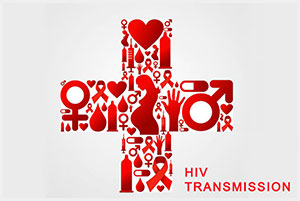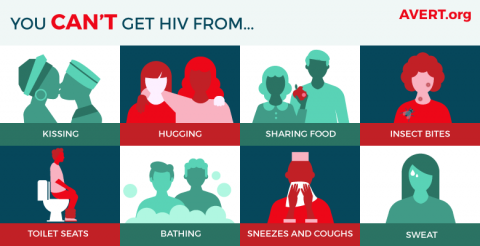Can You Get Aids Taking a Bath After Someone Else Had Aids in the Same Bed
HIV is a disease that affects the immune system. The allowed system is what helps us stay good for you and fight off infections.
HIV = human being immunodeficiency virus. It harms cells of the immune system, which over fourth dimension impairs its power to fight off infections. If untreated information technology can crusade AIDS (acquired allowed deficiency syndrome) which means someone's immune arrangement is under stress.
People living with HIV or AIDS can alive a long, normal, healthy life with the proper treatment.
Anyone can get HIV and it is near commonly spread past sexual contact with an infected partner.
How is HIV/AIDS transmitted?
HIV but lives in 5 torso fluids- blood, semen, vaginal fluids, breast milk and anal mucus.
1 of these trunk fluids has to go into the bloodstream which usually only happens in specific situations:
Sexual contact
HIV is spread nearly commonly by sexual contact with an infected partner. The virus enters the body through the lining of the vagina, vulva, penis, rectum, or rima oris during sexual activity.
Blood contagion
HIV may also exist spread through contact with infected blood. However, due to the screening of blood for evidence of HIV infection, the risk of acquiring HIV from claret transfusions is extremely low.
Needles
HIV is frequently spread by sharing needles, syringes, or drug use equipment with someone who is infected with the virus. Manual from patient to healthcare worker, or vice-versa through adventitious sticks with contaminated needles or other medical instruments, is rare.
Female parent to infant
HIV likewise can be spread to babies born to, or breastfed by, mothers infected with the virus.
HIV cannot be spread through casual contact such equally hugging, kissing, sharing a bath, towels or dishes.
HIV is not airborne and cannot be spread through:
- Saliva
- Sweat
- Tears
- Swimming pools
- Telephones
- Toilet seats
- Biting insects (such as mosquitoes)

What is HIV doing inside the body?
Once inside the body HIV is seeking out certain types of allowed system cells- CD4 cells. It takes over those cells and uses them to create more HIV, and those healthy cells die. The purpose of HIV handling is to stop that process so the torso tin function normally.
Picket video to acquire more
Symptoms of HIV/AIDS
Some people may develop a influenza-like illness within a calendar month or two later on exposure to the HIV virus. Many people do not develop any symptoms when they first go infected and if they do, they usually disappear within 1-4 weeks and are frequently mistaken for those of some other viral infection such every bit the flu. Symptoms may include:
- Fever
- Headache
- Malaise (feeling unwell)
- Enlarged lymph nodes
It can take a long time for ongoing symptoms to appear- up to ten years or more than. Fifty-fifty if someone doesn't feel ill, their body is still making HIV virus which ways they can give HIV to someone else. During this asymptomatic menstruation, (the period of time when someone feels no symptoms) HIV is actively infecting and killing cells of the immune organisation. This will be apparent with a reject in the blood levels of CD4+ cells—the immune arrangement's key infection fighters. This process tin can keep for quite some time before symptoms of HIV beginning to appear, just over fourth dimension as the immune system weakens, complications begin to surface. The post-obit are the most common complications, or symptoms, of AIDS. Each individual, notwithstanding, may experience symptoms differently. Symptoms may include:
- Lymph nodes that remain enlarged for more than iii months
- Lack of energy
- Weight loss
- Frequent fevers and sweats
- Persistent or frequent yeast infections (oral or vaginal)
- Persistent skin rashes or flaky skin
- Pelvic inflammatory disease that does not respond to treatment
- Short-term retentiveness loss
- Tuberculosis and certain types of pneumonia
Some people develop frequent and severe herpes infections that cause mouth, genital, or anal sores, or a painful rash known as shingles. The symptoms of an HIV infection may resemble other medical conditions. Always consult your physician for a diagnosis.
Diagnosis
Early HIV infection often causes no symptoms and must be detected by testing a person'due south blood for the presence of antibodies—disease-fighting proteins—against HIV. With a 4th generation HIV Test, these HIV antibodies can be detected as early every bit 10 days after being exposed to the virus through sex or from sharing needles. Most providers are using this test, merely it is e'er a good idea to inquire which examination is being used. The sooner HIV is detected and treated the better. When a person is highly probable to be infected with HIV and notwithstanding antibody tests are negative, a test for the presence of HIV itself in the blood is used.
If you or someone y'all know has whatsoever questions near this contact our office at 520-626-8598 or the CDC HIV/AIDS Hotline at HIV/AIDS Hotline In Arizona: (800) 448-0440 (CDC AIDS Info) or exterior of Arizona: (800) 458-5231 (CDC Hotline)
Watch video to learn more
Treatment
At that place are effective treatments for HIV that help people alive a long and healthy life. Treatment of consists often just one pill once a twenty-four hours with minimal side effects.
The goal of the HIV treatment is to reduce the amount of virus in someone'due south claret and suppress it. When the virus is suppressed it allows the immune organization to function improve and practice its chore, which is to go on people salubrious from infections. Viral suppression is also called "undetectable." Undetectable means there is so little virus in someone's blood the exam cannot give an exact number of how much virus is in at that place- the amount is too small. It does not hateful that the affliction has been cured. At this time, there is no cure for HIV, then someone living with the affliction has to have the medication every day to keep the virus at bay.
Watch video to acquire more
Protecting Others
Fifty-fifty if someone has no symptoms of HIV infection they can yet give the disease to someone through sexual activity or sharing needles.
HIV cannot be transmitted through coincidental contact like hugging, kissing, sharing bathrooms, towels, eating or cooking utensils etc, or past animals.
There are a lot of ways to foreclose giving HIV to someone else. Here are some things to call back:
Viral suppression or being undetectable is the best mode to reduce the risk of giving HIV to someone else (and it keeps the person with the disease good for you too)
Using safer sexual activity methods such as condoms are a great way to foreclose transmission of HIV and other sexually transmitted infections. Nosotros keep condoms in our clinic so just ask our staff if you would like some.
Now people who are not living with HIV tin have a daily medication to prevent them from getting the disease. It is called PrEP.
More most this medicine
To learn more than almost HIV visit www.hiv.gov
Source: https://hiv.medicine.arizona.edu/hiv-aids
Post a Comment for "Can You Get Aids Taking a Bath After Someone Else Had Aids in the Same Bed"